Manuscripts Etc.
| CLOSE WINDOW |

|
The following items are drawn from the William Faulkner Foundation Collection at the University of Virginia's Albert and Shirley Small Special Collections Library (http://small.library.virginia.edu/). |
|
Faulkner made this novel by revising eight stories he'd written separately and combining them with new material into what he called "a more or less continuous narrative." Selected typescript pages and a few other items for "The Old People," "A Point of Law," "Gold Is Not Always," "Pantaloon in Black," "Go Down, Moses" and "Delta Autumn" can be found at the sites for those stories elsewhere in Digital Yoknapatawpha. Here you'll find pages from the typescripts of the stories that were never separately published, or that were written directly for the novel. What follows is arranged chronologically, according to the available evidence, in order to explore the way that between early 1940 and late 1941 Faulkner's imagination reshaped the separate stories together into one of his most powerful novels. Faulkner was encouraged by the sale of "A Point of Law" to Collier's magazine in late January, 1940, to write two more stories about Lucas Beauchamp in February. The first of these, "Gold Is Not Always," was eventually bought by The Atlantic Monthly, but the second never sold. As you can see from the typescript titlepage below left, it was originally called "An ABSOLUTION"; sometime later Faulkner added a new title in pencil - "APOTHEOSIS." It looks like he used the same pencil to make notes to himself in the margin about expanding the story by adding details about the relationship between Edmonds and Lucas' wife "Mollie," as her name is spelled in the early versions of the story. The page below right is also from this typescript. On it you can see that Faulkner's first idea was for Edmonds to agree to help Mollie get the divorce she wants. 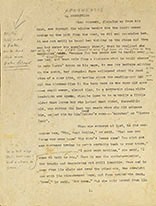 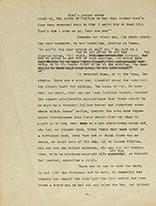 Those marginal notes (above left) - "Mollie. Wet nurse & doctor, mother died" - may have been inspired by the death in late January of Faulkner's own "mammy," Caroline Barr, "the old hundred-year-old matriarch who raised me," and to whom he would dedicate Go Down, Moses after finishing it two years later. The version of the story he sent his agent, Harold Ober, in mid-February had a new title - "The Fire on the Hearth" - and included the role Mollie played as Edmonds' mammy. Below are the first two pages of that version. There's no way to know what Faulkner meant by adding "No. 2" above the story's title. It's probably true, as scholars have suggested, that Caroline Barr's death helped Faulkner bring into focus the idea of a collection of stories about Negroes, the idea out of which the novel would eventually emerge, but "The Fire on the Hearth" is a long ways from what would become over two subsequent revisions "The Fire and the Hearth." In this second version there is still no hint of the McCaslin family history, and how it links the Edmonds and the Beauchamp families. 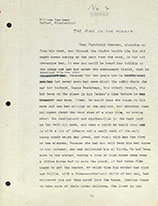 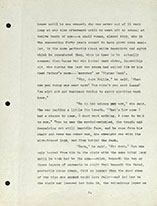 In March, Faulkner wrote "Pantaloon in Black"; its protagonist is not Lucas, but another black man, Rider, who also lives on the Edmonds plantation and who built a fire on his own hearth like the one that burns on Lucas'. Although it was rejected by four magazines before Harper's bought it in August, this fourth story with a black protagonist apparently helped point Faulkner's imagination toward the idea of a book-length collection of stories. Over the next two months he mentions that idea in four letters to Bob Haas, his editor at Random House. On April 28 he refers to the "chapters" that he has written "as short stories." On May 22 he refers to the "four stories about niggers" in Ober's hands, and proposes to "build onto them [and] write some more." On June 1 he more formally proposes "a connected book-length mss." And on June 7 he describes the proposed book as "a more or less continuous narrative, somewhat after THE UNVANQUISHED." The first two letters also used this comparison. The Unvanquished (1938) had brought together six published magazine stories about a teenage Bayard Sartoris during the Civil War and one new one set during Reconstruction into a sort of coming-of-age narrative; Faulkner's comparison implies that the new, as yet untitled book will be similarly unified, perhaps by the fact that its present-day Negro characters all live on Roth Edmonds' land. The n-word Faulkner uses to describe the stories would not have grated as harshly on Haas' ears as it does on ours, but Faulkner's use of it suggests that the book he was thinking of lacked the deep moral purpose of the novel he ended up writing. It would not be until May, 1941, that Random House committed itself to publishing the idea. By that time, Faulkner's plan for the book included "The Old People," which had been written shortly before "A Point of Law," well before he had considered writing a book about Negroes. (For more, see "The Old People" section of Digital Yoknapatawpha.) Similarly, when at the end of June, 1940, he wrote the first version of "Was," it was not with such a book in mind either, as we can see by comparing "Almost," as he originally called the story, with "Was" as it appears as the first "chapter" of the novel. Since it includes a page "3A" (below right), the unpublished, untitled 22-page typescript in the Faulkner Foundation Collection cannot be the very first draft of the story. Even this revised version, however, makes no connection between the McCaslin twins (Buddy and Buck) and the Edmonds family; nor does it contain any suggestion that the runaway slave Tomey's Turl is a "white half-McCaslin"; and in it the boy helping to recapture him is not Cass Edmonds, but Bayard Sartoris - who in "Vendee" had chased down Grumby with Buck and Ringo (see pages 1-2, below left and center). 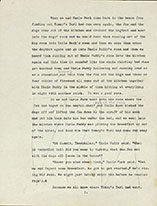 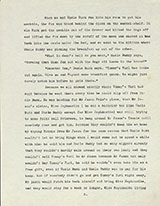 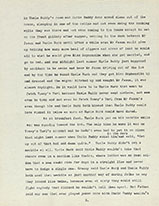 When the Saturday Evening Post declined the story, Ober sent it back to Faulkner with suggestions for further revisions, which Faulkner acted on before returning the story to Ober. In the accompanying letter, Faulkner notes that after he interpolated his changes, the story "Might do with retyping." The extant typescript is too neat to be the one he sent back, so we don't know exactly what the story included by the end of July. However, it certainly did not yet include the revisions - Bayard to Cass Edmonds, Tomey's Turl to Buck and Buddy's half-brother - by which Faulkner made the story's comedy also serve to introduce the novel's tragic elements. Below: pages 3 and 20, which again show how far the original conception of the story is from the novel's subject matter; Buck and Buddy have not moved out of their father's big house to accommodate their slaves there (page 3), and the light that "Jason Prim" (as Faulkner originally named the Hubert Beauchamp character) shines on Tomey's Turl at the climax of the poker game reveals no hint of a mixed-race ancestry (page 20).  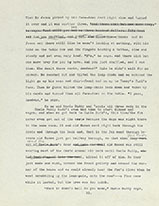 Also in July, 1940, Faulkner wrote "Go Down, Moses," the short story about Mollie Beauchamp asking for Gavin Stevens' help to find her grandson that would provide the novel Go Down, Moses with both its title and its concluding chapter. Faulkner presumably did write this with the proposed book in mind - its black characters are also connected with Roth Edmonds' place - but the fact that he originally called the grandmother "Rosa Sutpen" and her grandson "Henry Coldfield Sutpen" indicates that the idea of organizing the book's narrative around McCaslins and Beauchamps as well as Edmondses has not yet occurred to him. Later in 1940 Faulkner wrote "Delta Autumn." At the center of this story is Ike McCaslin, the character who in the novel provides a way to pull the two sets of stories - about hunting and about blacks - into one more or less continuous narrative. But the story's details show that, like "Almost|Was," it was conceived apart from the book. The part that would be played in the novel by Roth Edmonds is in the story assigned to a man named Don Boyd, and there is no hint that his black mistress is related to anyone in the story. (See these stories elsewhere in Digital Yoknapatawpha for more.) The evidence suggests that it wasn't until the spring of 1941, a year after he had first mentioned the idea for a book about blacks to his publisher, that Faulkner had the insight - equally creative, sociological and moral - that defines the achievement of Go Down, Moses. On May 1, 1941, he reminded Haas about the "volume" he had proposed "last year." At this point the book has its title, and a much more specific focus: its "general theme," he wrote, "being [the] relationship between white and negro races here." Haas' reply was encouraging, and less than two weeks later Faulkner wrote again to say "I am at work on the mss." The list of contents in the May 1 letter consists of "The Fire and the Hearth," "Pantaloon in Black," "The Old People," "Delta Autumn" and "Go Down, Moses," though he adds that "some additional material may invent itself in the process." The May 13 letter adds "Was" to the list, an addition that leads toward the way, in the novel, Faulkner locates his representation of racial relationships in a historical context that stretches back to slavery and its sins. By this time he may even already be thinking about making the novel's central racial "relationships" a family affair, by having Beauchamps and Edmondses and McCaslins all descended from the same slave-owning white patriarch, Lucius Quintus Carothers McCaslin, father to Buck and Buddy - and both father and grandfather to Tomey's Turl. Given the significance of that revisionary act, it would be great if we could identify with some exactness the moment when Faulkner first imagined Carothers McCaslin as the polluted source from which the lives of the novel's major characters, black and white, all flow. We can't. But that moment may be preserved on a single piece of paper in the Faulkner Foundation collection. The fragmentary genealogical chart below in Faulkner's handwriting may have been created around the time when he first realized how he could connect the McCaslin and Beauchamp families through Tomey's Turl. The "n" after both his name and Eunice's stands for Negro. 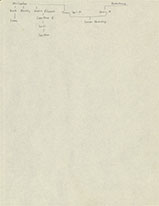 Faulkner will make one other major change later, when he attaches the name "Eunice" to Tomey's Turl's grandmother (and renames the sweetheart at the Beauchamp plantation "Tennie"). But the crooked line at the top of this page that connects McCaslin and Beauchamp across the color line makes Isaac and Lucas both grandsons of Old Carothers, and re-revises almost every one of the stories that Faulkner intends to include in the novel. Only "Pantaloon in Black" is unaffected. For example, when Buck and Buddy go after the runaway in "Almost|Was," they are now chasing down their own half-brother. Now, when Isaac learns woodcraft from Sam Fathers in "The Old People," the trans-historical values he is learning in the wilderness can be juxtaposed against the immorality he will track down in his own family history. It may have been at about the same time as he drew that crooked line that Faulkner realized his book needed one very substantial piece of "new material": sometime in the summer, 1941, he began writing "The Bear," in which he reaches back to an even earlier hunting story, "Lion" (1935), to find the basis for one of his most demanding and brilliant works. He was writing and rewriting so quickly that he made no carbon copy of "The Bear." The five pages below are from the typescript that Random House used to set the novel in print, and many of the marks on them belong to employees of the publishing house. But because, to save time, Faulkner sent this typescript to New York in batches as he was preparing it, some of the revisions he made in the story can be recovered. Page 247 (left) is from the first version of the typescript, while the page next to it - 247A - is one of about 11 new pages that he sent in with the next batch; note the instructions at the top of the page to his editor, Saxe Commins. These 11 pages revise and expand 6 earlier ones, describing Sam Fathers' death and launching Section 4. That section begins on page 253 (center). By reminding Commins about a previous note on "9 Nov 41," this note helps us date these revisions in "The Bear." But Faulkner's concern is to ask his editor to take good care of two things. (1) "Set as written" is Faulkner's way of demanding that no changes be made in the unconventional style of the section - he was anxious enough about this to repeat the instruction, more explicitly and insistently, in a "Note to Printer" on the next page below, 253B. (2) "Remove italics from all pages bearing red instruction at top. Other italics O.K." refers to a change that Faulkner himself has decided on at this late stage in the novel's production. As you can see from the last page below, he originally underlined - the only way his manual typewriter allowed him to italicize a passage - at least the section's opening pages; he may even have planned to italicize the whole of it, in the manner of chapter 5 of Absalom!. The 10 pages between 254 and 263 are all underlined in this way, but in red at the top of each of them Faulkner has put a version of the instruction you can see here, "No italics. Continue same typeface as before." Given the stylistic difficulties of Section 4 as presented in the published text, most readers are probably grateful he decided against italicizing it, but it's interesting to imagine how the story that that section tells would be changed if it had remained in italics. 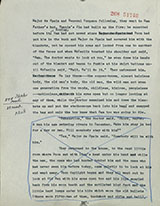   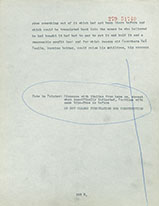 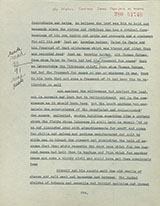 Faulkner worked hard on the book between May and December, 1941, and there's no doubt that several key revisions occurred recursively. For example, in November he asked Haas to send him back "the first chapter or section, title Was," so he could make some additional changes. Unfortunately, there's no way to determine what those were. The Faulkner Foundation collection includes several drafts of "The Fire and the Hearth," as Faulkner decided to call the novella he wrote by combining his three stories about Lucas and Molly (as he is now spelling Mollie) with new material using Lucas' experiences to bring out sharply the most painful aspects of interracial relationships "here," in the segregated South. The first four typescript pages below are most likely from the first sets of revisions, made before he had decided to precede the story with "Was" - at least, that's what the number "1" on the second page suggests (and both versions of the unnumbered second page below follow directly from that page "1"): ![Version 1, Page 1, Fire and Hearth Ts Version 1, Page [1], Fire and Hearth Ts](http://faulkner.iath.virginia.edu/media/resources/MANUSCRIPTS/FIREANDTsP0t.jpg)  ![Version 1, Page [2], Fire and Hearth Ts Version 1, Page [2], Fire and Hearth Ts](http://faulkner.iath.virginia.edu/media/resources/MANUSCRIPTS/FIREANDTsP00t.jpg) ![Version 2, Page [2], Fire and Hearth Ts Version 2, Page [2], Fire and Hearth Ts](http://faulkner.iath.virginia.edu/media/resources/MANUSCRIPTS/FIREANDTsP000t.jpg) The four pages below were clearly typed later, after Faulkner decided to include "Was" in the novel. Here the story's first page (center left and right) begins with page "29." And the back of the first first page (below left) shows how he thought of giving each story a separate titlepage. A lot can be learned from these typescripts, including how providing dates for the chapters|stories, as he did on the discarded "Was" titlepage below left, would have located them even more explicitly in a historical context. But none of the various extant typescript pages from this stage in the revision process identify Lucas as a descendant of Old Carothers. In a cancelled phrase on page "54" (below right) Lucas even refers to Cass Edmonds, not Carothers McCaslin, as "Old Master." 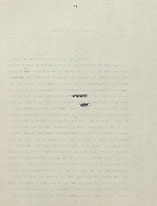 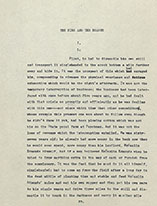   The 418-page setting typescript is almost identical with the published text, but the Faulkner Foundation collection also contains a stack of discarded pages from this final stage in the book's composition. They suggest that it was only at this point, sometime between June and December, 1941, that Faulkner remade the stories over into the novel we read, which arranges (almost all) its separate narrative arcs together around a center defined by Ike applying the morality he learned in the woods to hunt down his grandfather's sins in the records of his family's slave plantation, and then bends (almost) all the arcs into a kind of vicious circle when Roth Edmonds re-enacts that antebellum past on the eve of World War II. In the end the novel took Faulkner much longer than he expected, and likely took him thematically into places he had not imagined going until after he began "working on the mss." The book's various parts don't quite fit together seamlessly, but there's no doubt that the powerful book that emerged from his creative ferment is much much greater than the sum of its earlier written parts. Citing this source:
|
